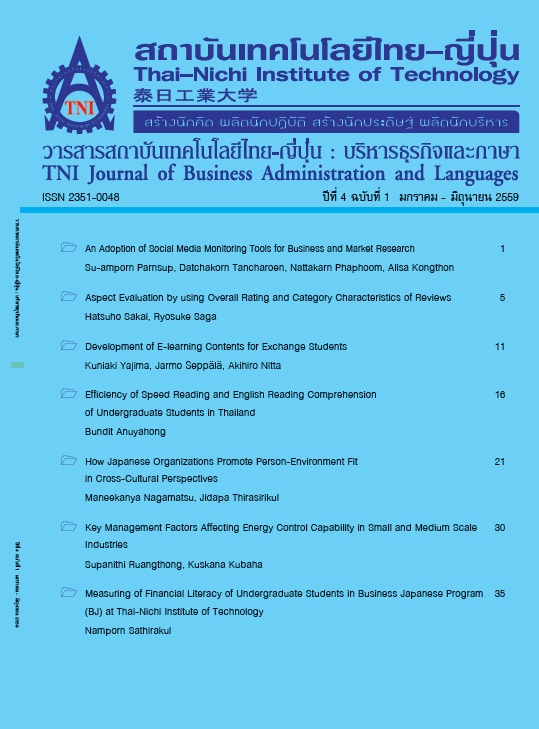How Japanese Organizations Promote Person-Environment Fit in Cross-Cultural Perspectives
Main Article Content
Abstract
This research aimed to study the culture environment administration of Japanese Transnational Enterprises in Thailand and developed the new framework of Person-Environment fit (P-E fit) in cross cultural perspective by multi level analysis.
The research method is a documentary research technique. under the framework of Person-Environment fit (P-E)fit that compose of Person-Organization fit(P-O fit), Person-Group fit (P-G fit) and Person- Person fit (P-J fit), which is basically indicates between characteristics of people and their culture environments results in positive outcomes for both individual and organizations.
The research found that the model of Japanese organization promoting Person-Environment fit (P-E fit) in cross culture perspective should be composed of Person-Organization fit(P-O fit), Person-Group fit (P-G fit) and Person- Job fit (P-J fit), which is indicating the relationship between individual culture and their culture environment resulted in positive outcome of individual and organization. The case and new model suggest that institutional and cross cultural contexts affect the way organizations promote Person-Environment fit (P-E fit).
Article Details
Article Accepting Policy
The editorial board of Thai-Nichi Institute of Technology is pleased to receive articles from lecturers and experts in the fields of business administration, languages, engineering and technology written in Thai or English. The academic work submitted for publication must not be published in any other publication before and must not be under consideration of other journal submissions. Therefore, those interested in participating in the dissemination of work and knowledge can submit their article to the editorial board for further submission to the screening committee to consider publishing in the journal. The articles that can be published include solely research articles. Interested persons can prepare their articles by reviewing recommendations for article authors.
Copyright infringement is solely the responsibility of the author(s) of the article. Articles that have been published must be screened and reviewed for quality from qualified experts approved by the editorial board.
The text that appears within each article published in this research journal is a personal opinion of each author, nothing related to Thai-Nichi Institute of Technology, and other faculty members in the institution in any way. Responsibilities and accuracy for the content of each article are owned by each author. If there is any mistake, each author will be responsible for his/her own article(s).
The editorial board reserves the right not to bring any content, views or comments of articles in the Journal of Thai-Nichi Institute of Technology to publish before receiving permission from the authorized author(s) in writing. The published work is the copyright of the Journal of Thai-Nichi Institute of Technology.
References
R. E. Alison, “Neo-Confucianism in human relations of Japanese management,” Asian Culture Quarterly, vol. 17, no. 3, pp. 57-70, 1989.
B. Corine and D. H. Deanne N., “Human Resource Management, Person-Environment Fit and Trust,” in Trust and Human Resource Management, Cheltenham : UK: Edward Elgar, 2011, pp. 109 - 121.
C. Jennifer A., “Matching People and Organizations: Selection and Socialization in Public Accounting Firms,”Administrative Science Quarterly, vol. 36, no. 3, pp. 459 – 484
Edwards, J. R., & Shipp. A. J., “The relationship between person-environment fit and outcomes: An integrative theoretical framework” In C. Ostoroff & T. A. Judge (Eds.), Perspectives on organizational fit. San Francisco: Jossey-Bass, 2007 pp. 209-258
H. Geert H., Culture’s consequences : international differences in workrelated values. Beverly Hills: Sage Publications, 1984.
K. Suntaree, Psychology of the Thai people : values and behavioral patterns. Bangkok: Research Center, National Institute of Development Administration, 1991.
K.B. Amy, Z. Ryan D., and J. Erin Johnson, “Consequences of individuals’ fit at work: A meta-analysis of person-job, person-organization, person-group, and person-supervisor FIT,” Personnel Psychology, vol. 58, no. 2, pp. 281-547, 2005.
S. Benjamin, “The People Make the Place,” Personnel Psychology, vol. 40, no. 3, pp. 437-453, 1111-1987.
S. Tomoki, “Person-Organization Fit and Person-Job Fit in Employee Selection,” Osaka Sendai Honshu, vol. 54, no. 6, pp. 179 - 191, 2004.
S. Tomoki, “How organizations promote person-environment fit: using the case of Japanese firms to illustrate institutional and cultural influences,” Asia Pacific Journal of Management, vol. 23, no. 1, pp. 47-69.
S. Fredric William and O. Jun, “Culture and conflict: Japanese managers and Thai subordinates,” Personnel Review, vol. 32, no. 2, pp. 187 - 210, 2003.


